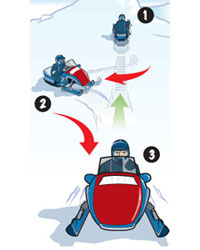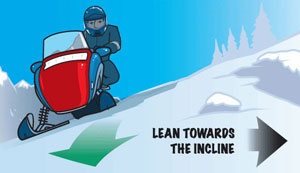Snowmobiling 101: Riding Hills
Fresh Air Educators 02.27.12

Taking on the Hills
When it comes to dealing with hills on a snowmobile, it will help to read our previous installment on riding positions. Attacking a big climb can be the highlight of your day, but you’ve got to know how to position your body and handle your sled.
Riding Uphill

When you come up to a big climb you’re best served to adjust to a kneeling position and begin leaning forward. Your chest should be positioned over the handlebars somewhat. A good tip for beginners is to shift your weight to the rear and lean forward before transitioning to the kneeling position. If the hill is particularly steep, you may have to switch from a kneeling to a posting position. This will be a little more physically exerting, but it will place more forward pressure on the track increase traction.
 Once you start your ascent you should never let up on the throttle. Stopping or even slowing down may cause you to lose momentum, which can make it very difficult to continue climbing if the hill is high and steep enough. Instead of letting up on the throttle you should apply it even more to maintain your speed during the climb.
Once you start your ascent you should never let up on the throttle. Stopping or even slowing down may cause you to lose momentum, which can make it very difficult to continue climbing if the hill is high and steep enough. Instead of letting up on the throttle you should apply it even more to maintain your speed during the climb.
If you do lose forward momentum when trying to climb you should not attempt to continue your ascent. Instead you should stop the snowmobile and make a K-turn to return down the hill.
If you need to perform a K-turn you should move to a seated position while continuing to lean forward and apply the brakes. With the brakes still applied, turn the handlebars completely towards the left. Shift the snowmobile into reverse and release the brake lever. Leaning into the hill, gently feather the throttle and carefully proceed in reverse until your snowmobile is perpendicular with the slope of the hill. Once the snowmobile is perpendicular, apply the brakes to bring it to a stop. With the brakes still applied, turn the handlebars towards the right (downhill direction). Release the brake lever and slowly descend the hill.
Riding Downhill
 Once you learn how to climb a hill it only makes sense that you’ll have to learn how to get back down. When you do come to a downward slope you should make sure that no snowmobiles are coming up the hill. If there are other snowmobiles on the hill let them go before proceeding.
Once you learn how to climb a hill it only makes sense that you’ll have to learn how to get back down. When you do come to a downward slope you should make sure that no snowmobiles are coming up the hill. If there are other snowmobiles on the hill let them go before proceeding.
Once you begin your descent get yourself in a seated position and shift your weight toward the back of the snowmobile. As you start downhill, feather the throttle to keep the drive belt engaged and let gravity do most of the work. To maintain control apply the brake intermittently and gradually throughout the descent. Be sure not to brake too hard as this could cause you to slide or lose control.
Crossing a Hill
 Crossing a hill, or sidehilling, is a favorite of the steep and deep riders of the west. Good riders make this look easy, but there is a lot of skill involved.
Crossing a hill, or sidehilling, is a favorite of the steep and deep riders of the west. Good riders make this look easy, but there is a lot of skill involved.
When crossing a hill choose a riding position that will allow you to easily and comfortably shift your weight towards the slope of the hill. The kneeling position is a good choice, but make sure you kneel with your downhill leg. Also, always keep your bodyweight leaning towards the uphill direction. If you lean downhill you are going to roll.
Beware of hard-packed snow while crossing a hill as it can cause your snowmobile to slide. Always try to cross on snow that is more loosely packed if possible.
If you lose control of your snowmobile while crossing, climbing or descending a hill and it begins to roll you should jump off immediately on the uphill side. This will ensure the snowmobile doesn’t roll over top of you.

